

 Comparison is the thief of joy…
Comparison is the thief of joy…
…unless you’re running a business.
Competitive intelligence is a vital part of running and growing a business, particularly in today’s complex B2B sales environment. While there are many ways to gather it, one often overlooked method is Win / Loss analysis. This involves interviewing clients you’ve won and prospects you’ve lost to understand why they chose—or didn’t choose—to work with you. In doing so, this research also gathers valuable insights into why these prospects did or did not go into business with your competitor.
Speaking to decision-makers soon after buying decisions have been made helps you develop a deeper and more nuanced understanding of your customer, your competition, and your organization’s competencies and areas for opportunity.
Through our experience with interviewing and assessing thousands of competitive situations, here are some key ways Win / Loss research can enhance and improve your competitive advantage:
Using These Insights to Improve
Keep these best practices in mind
Win / Loss analysis is an invaluable tool that helps you understand your customers’ needs, innovate, and improve your positioning—all from the customer’s perspective. If you’re looking to implement a successful Win / Loss program, check out our guides on “Running an Effective Win/Loss Program in 2024” and “How to Get Win/Loss Right.”
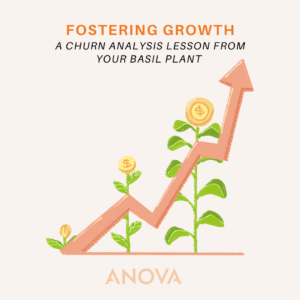 Keeping a plant alive seems simple: water it, give it sunlight, and watch it grow. But whether you are a hobby gardener just starting out or an experienced horticulturalist trying something new, the reality can often be different. The leaves start browning, stems wilt, and before you know it, you’re left with a pot of withered remains. The problem? Most of us are left guessing what went wrong.
Keeping a plant alive seems simple: water it, give it sunlight, and watch it grow. But whether you are a hobby gardener just starting out or an experienced horticulturalist trying something new, the reality can often be different. The leaves start browning, stems wilt, and before you know it, you’re left with a pot of withered remains. The problem? Most of us are left guessing what went wrong.
Much like a fledgling plant enthusiast trying to keep their potted basil plant alive, businesses often struggle with client retention. When a customer leaves, the natural reaction is to ask, “Why?” Without clear feedback, you’re left with a mix of generic advice: “Maybe you’re offering too little value,” “Maybe your product needs more features,” or “Perhaps the customer service isn’t up to par.” These are all valid points, but none provide specific answers tailored to your business. This begs the question, what can we do to get clearer answers and take effective action? How can we learn the right way to cultivate our basil plants (and customers) to ensure they are thriving, not dying?
The Power of Direct Feedback: Asking the Basil
Instead of guessing, imagine if you could ask your basil directly: “What’s wrong?” Maybe it would tell you it needs more sunlight, or less water, or perhaps a different kind of soil. The same principle applies to understanding why customers churn. Direct feedback from the customer—right at the point of their departure—is invaluable. It eliminates the guesswork and lets you address the real reasons clients are leaving.
To do this effectively, companies need to implement a structured feedback process. Here are a few steps to consider:
The Lesson? Ask, Don’t Assume
Churn analysis, at its core, is about listening to your clients and responding to their needs. Just as asking the basil would save time and energy (and maybe save the plant), asking your clients why they left can prevent future churn. Instead of guessing and wasting resources on trial and error, direct feedback provides a clear path to actionable insights.
Take the guesswork out of your business. Ask the basil—and more importantly, ask your clients.
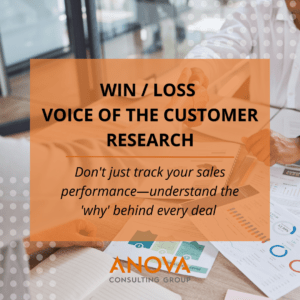 This blog was written by Bredon Attridge, Engagement Manager at Anova.
This blog was written by Bredon Attridge, Engagement Manager at Anova.
The Hidden Power in Win / Loss Research
You’ve meticulously crafted your sales strategy, honed your team’s skills, and implemented the latest CRM technology. The problem? Your competition has followed the same playbook. So, how do you take your sales approach to the next level? How can you give your team the edge over the competition?
The answers lie in a powerful, yet often ignored, approach: Win / Loss Voice-of-the-Customer (VoC) research. Currently, less than 30% of companies include this uniquely insightful program as part of their sales process. By systematically capturing candid feedback from both your winning and losing deals, you gain invaluable insights into the factors that differentiate success from defeat.
Why It Matters
Traditionally, sales performance analysis focuses heavily on win rates and activity metrics. And while valuable, this data paints an incomplete picture. Win / Loss VoC research goes beyond the numbers, providing a qualitative dimension that unveils the “why” behind your sales outcomes.
Win / Loss research empowers your sales organization in invaluable ways:
Anova is passionate about helping businesses unlock the transformative power of Win / Loss. Our highly customized approach is designed to help guide you through every stage of the process and return insights that are truly actionable.
Why Partner with a Third-Party for Win/Loss Research?
External partners provide insights that internal teams often miss. By regularly collecting feedback and adapting your approach, Anova’s clients create a dynamic sales engine that improves quarter by quarter.
Key Benefits of Anova’s Customized Win/Loss Solution
By integrating Win / Loss VoC research into your sales strategy, you can turn customer insights into powerful tools that help your team get ahead of the competition.
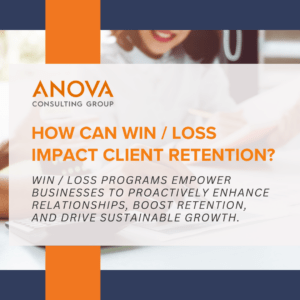 This blog was written by Brian McMahon, a Consultant at Anova.
This blog was written by Brian McMahon, a Consultant at Anova.
Client Satisfaction Ratings, Net Promoter Scores, and Customer Listening Programs – companies employ many strategies to understand the perceptions of their client base and boost client retention. A key strategy that often goes underutilized in this pursuit is a comprehensive win/loss program. This program, focused on analyzing why deals are won or lost, can be a goldmine of insights for organizations looking to strengthen their client relationships and improve retention rates. Let’s delve into how a win/loss program can be a game-changer in client retention:
Illuminate Your Competitive Advantages and Disadvantages
A win/loss program acts as a spotlight on your organization’s strengths and weaknesses in the eyes of clients. By dissecting why you win deals, you uncover your key competitive advantages, be it product superiority, pricing strategies, or exceptional customer service. Conversely, understanding why you lose deals reveals areas that need improvement, whether it’s gaps in your offerings, ineffective sales tactics, or shortcomings in delivery. This illumination empowers you to fortify your strengths and address weaknesses proactively, enhancing client satisfaction and loyalty.
Gain Insights into Client Strategies
Beyond self-analysis, a win/loss program provides invaluable insights into your clients’ strategies. It uncovers how they approach winning business, the value propositions they emphasize, and the tactics they employ. This knowledge not only helps you better understand your clients’ needs and preferences but also equips you to anticipate their moves and align your offerings accordingly. Furthermore, it unveils potential threats from competitors who may be targeting your clients, enabling you to preemptively counter such challenges and solidify your relationships.
Identify Areas for Relationship Strengthening
Winning deals doesn’t always mean a flawless relationship. A win/loss program reveals the cracks in your client relationships by highlighting what you are winning despite and the weaknesses that new clients bring to the table. This insight is crucial in mitigating issues before they escalate, fostering stronger partnerships, and ensuring long-term client retention. By addressing these vulnerabilities early on, you demonstrate proactive engagement and commitment to client success, earning their trust and loyalty in the process.
Understand Client Defections
One of the most valuable aspects of a win/loss program is its ability to uncover why clients leave and seek services elsewhere. Whether it’s dissatisfaction with your offerings, better deals from competitors, or unmet expectations, understanding the root causes of client defections arms you with actionable intelligence. This knowledge enables you to tailor retention strategies, address pain points, and implement corrective measures to prevent future defections. It also offers an opportunity to win back lost clients by addressing their concerns and showcasing improvements.
In Conclusion
A well-executed win/loss program goes beyond analyzing wins and losses; it serves as a strategic tool for enhancing client retention. By shedding light on competitive advantages, understanding client strategies, identifying areas for improvement, and learning from client defections, organizations can strengthen their client relationships, boost retention rates, and drive long-term business success. Embracing a proactive approach to client insights through a win/loss program is not just a competitive advantage but a cornerstone of sustainable growth and profitability in today’s dynamic business environment.
Collin Stewart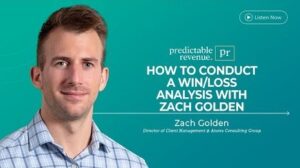 from Predictable Revenue interviews Zach Golden, Director of Client Management at Anova Consulting Group, to explore the value of win / loss analysis in sales. Despite its significant potential to boost revenue—up to 50% according to Gartner—win-loss analysis is underutilized by most companies. Zach explains how this analysis provides critical insights into why deals are won or lost, helping companies refine their sales strategies and better understand customer needs.
from Predictable Revenue interviews Zach Golden, Director of Client Management at Anova Consulting Group, to explore the value of win / loss analysis in sales. Despite its significant potential to boost revenue—up to 50% according to Gartner—win-loss analysis is underutilized by most companies. Zach explains how this analysis provides critical insights into why deals are won or lost, helping companies refine their sales strategies and better understand customer needs.
Effective win-loss analysis involves careful timing, unbiased feedback collection, and continuous iteration. While technology can assist with data processing, the human element remains crucial for gaining deeper insights through empathy and shared experiences. Ultimately, win / loss analysis is a strategic tool that can drive business growth, enhance customer-centricity, and provide a competitive edge. By embracing win / loss, companies can unlock valuable insights that drive growth and outsmart the competition.
The podcast is available on the Predictable Revenue website as well as on Youtube.
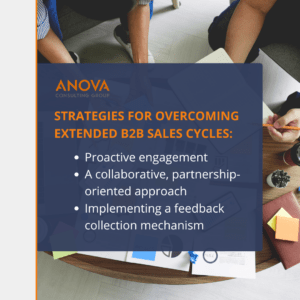 This blog was written by Brian McMahon, Consultant at Anova.
This blog was written by Brian McMahon, Consultant at Anova.
It’s not just you. Anyone involved in B2B sales over the past couple of years has experienced the frustration of deals that simply never seem to close.
Sales cycles are certainly lengthening, and the data backs it up. Below are just some of the statistics that demonstrate this unfortunate shift in how buying decisions are being made.
Purchase Process Stalls: According to Forrester, nearly 90% of global B2B buyers indicated a purchase process stall in 2023, underscoring the complexities and delays inherent in today’s sales environments.
Deal Stagnation: In 2023, approximately 60% of deals ended up in no decision, highlighting the growing trend of prolonged decision-making processes and the hurdles faced by sales teams in closing deals.
Information Overload: 63% of buyers feel overwhelmed with information, while 74% express that there are too many options to consider, creating barriers to swift decision-making and contributing to sales cycle extensions.
Buying Team Dynamics: The average buying team size ranges between approximately 7 individuals, as reported by HBR, to a substantial 14 – 23 people, according to Gartner, emphasizing the intricate dynamics and diverse stakeholders involved in B2B purchasing decisions.
This reticence to buy is a roadblock to closing and developing business, and with this challenge, client retention and expansion of course becomes a major focus. Listed here are some of the key reasons why client retention is increasingly vital in the face of these lengthy sales cycles:
Stable Revenue Streams: Retaining existing clients ensures a consistent flow of revenue, mitigating the impact of deal stagnation and purchase process stalls on overall business performance.
Cost-Effectiveness: The cost of acquiring new customers is significantly higher than retaining current ones, making client retention a cost-effective strategy, especially in environments characterized by prolonged sales cycles.
Cross-Sell and Upsell Opportunities: Satisfied clients are more receptive to cross-selling and upselling efforts, presenting lucrative opportunities to expand product / service offerings and increase customer lifetime value.
To retain clients an organization has to keep them satisfied as well as continually deliver value. Over the thousands of client satisfaction, renewal, and pre-RFP interviews Anova has done, the most effective strategies in doing so are:
Proactive Engagement: Foster regular communication, personalized interactions, and proactive problem-solving to strengthen client relationships and enhance loyalty.
Collaborative, Partnership-Oriented Approach: Adopt a collaborative mindset by aligning with clients’ goals, providing strategic guidance, and co-creating solutions to build trust and empower your clients, which enhances client loyalty.
Implement a Feedback Collection Mechanism: Ensure you catch developing pain points as quickly as possible and identify areas for opportunity within existing clients by continuously providing them avenues to provide feedback on the relationship.
If you demonstrate to your client you are a true partner looking to grow with them and empower and enable them along the way, it puts you in an ideal position to sell additional, value-added services that are closely aligned with their needs and goals.
As B2B sales cycles continue to lengthen and challenges such as purchase process stalls, prioritizing client retention emerges as a strategic imperative for sustained business success. By leveraging client retention strategies, businesses can expand from outside the complexities of extended sales cycles, capitalize on cross-sell and upsell opportunities, and cultivate enduring partnerships that drive growth and resilience in today’s competitive landscape.
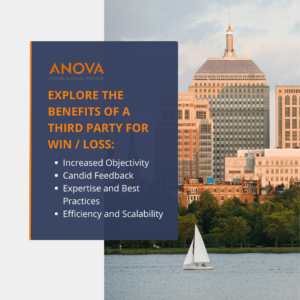 This blog was written by Harriet Peabody, Research Analyst at Anova.
This blog was written by Harriet Peabody, Research Analyst at Anova.
There are several advantages to using a third-party for your win/loss program compared to running it in-house:
Increased Objectivity and Candid Feedback
Reduced Bias: A key benefit is reduced bias. Customers may be hesitant to give completely honest feedback to your own sales team, fearing it might hurt their chances in future deals or damage relationships. A neutral third-party interviewer can create a safe space for customers to provide frank and open feedback. Using a third-party also allows for confidentiality, should the respondent wish for it, meaning you can still receive honest feedback from those who would be unwilling to provide it without anonymity.
Unfiltered Insights: Third-party interviewers are unlikely to have preconceived notions or try to downplay negative feedback. This can lead to a more objective and unfiltered view of your strengths and weaknesses. Having access to candid feedback on won and lost deals allows you to adjust accordingly and perform better going forward with the confidence that you are not acting on misinformation.
Expertise and Best Practices
Win / Loss Interviewing Skills: Third-party providers specialize in win / loss analysis and have trained interviewers experienced in conducting effective and insightful customer conversations. They know the right questions to ask and techniques to draw out valuable information. Anova’s interviewers are all experienced industry experts and are well versed in the Win / Loss space as well as the client’s area of business. This expertise shows through in the interviews and is clear to the contacts they are reaching out to as well, boosting Anova’s response rate, which is around 50-60%, well above the industry average.
Consultative approach: Anova has expertise in all aspects of program best practices, as we have been in the business for over 20 years. We will help you set up the logistics of the program, including the selection of deals to include in the program, tailoring the interview guide to your business’ needs, and staying in touch with updates and suggestions for success over the course of the program.
Benchmarking and Industry Insights: Third-party providers have experience across various industries. They can compare your findings to industry benchmarks and provide insights into how your performance stacks up against competitors. Anova has a broad client base and can provide competitive insights and benchmarking for numerous verticals, such as financial services, enterprise technology, healthcare, and more, helping you to remain competitive in your environment.
Efficiency and Scalability
Reduced Time Commitment: Running a Win / Loss program internally requires time and resources from your sales team and other departments. A third-party handles the entire process, freeing up your team to focus on core business activities. With Anova, you will have a designated client team running your program and available for any day-to-day needs.
Scalability: Third-party solutions can easily scale your win / loss program to accommodate a growing number of deals and interviews. This is particularly beneficial for companies with a high sales volume.
In summary, not only is using a third-party easier and timesaving for you, but it boosts program success by getting to the root of any issue through thorough and objective feedback, promoting win / loss best practices, and offering competitive intelligence and industry benchmarking.
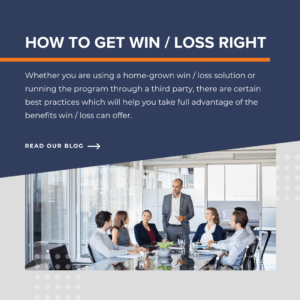 This blog was written by Harriet Peabody, Research Analyst at Anova.
This blog was written by Harriet Peabody, Research Analyst at Anova.
A successful win / loss program offers a wealth of benefits for businesses by providing valuable insights into customer behavior and overall sales effectiveness and can help businesses to continuously improve in order to stay competitive. However, if a win / loss program is not executed or utilized correctly, this limits the advantages one can gain from it. Whether you are using a home-grown win / loss solution or running the program through a third party, there are certain best practices which will help you take full advantage of the benefits win / loss can offer.
In our experience here at Anova, one of the biggest hindrances to program success is at the deal-flow level. The most important thing for program success is having sample to work with. There are two ways companies run into problems here:
Relying solely on CRM data can make it difficult to reach the contacts you are targeting, as this data is often inaccurate. You need to ensure you are reaching the right contact who will have the best insight into the sales process, and that the contact information you are using is correct.
This issue has to do less with logistics and more with company culture. Here at Anova, one of our values is a growth mindset, which is fostered by feedback. It is important to learn and grow from feedback, rather than reacting defensively. If salespeople fear negative repercussions from submitting a lost deal for feedback, they will miss out on an important learning opportunity. A company with a culture that is open to feedback will encourage salespeople to learn from their losses without fear of ramifications.
In putting the process into place for win / loss, ensure that representative deals are chosen for feedback, including a split of both wins and losses, and that the interviews occur shortly after the sales process to get the most relevant and accurate data. In our experience, a phone interview has the best results, both for the quality of data collected and the response rate, as opposed to an online survey. Tailor your interview guide according to your business and what you are looking to learn.
When it comes to the analysis and insights phase of the program, if you are running a home-grown solution, you will need to take on the data analysis and present the results in an effective way. Use the interview data to identify trends and recurring themes. Look for common reasons for wins and losses, competitor strengths and weaknesses, and areas for improvement in your sales process or product offering. Equally important to the insights gleaned from the data is what you do with them. For best results, present the findings in a clear and concise way in order to help stakeholders easily understand the key takeaways.
Throughout your program, internal or external, ensure the interviews are distributed to the stakeholders who will be able to learn and take action from them – and the same goes for the program end results. Not only should you distribute the findings liberally in your organization, but you must also develop concrete action plans based on the insights. This could involve sales training, product enhancements, or adjustments to marketing messaging.
Whether run internally or with a third party, there are aspects of all steps of the win / loss process which are under your control and will improve program success for your company. In keeping with a growth mindset, a win / loss program is something that should be sustained year over year. If you are striving for continuous improvement, you can never rest on your laurels, and should be seeking feedback and looking for new ways to grow indefinitely. The most successful programs are years in the making, giving you years of historical data to analyze for trends and track your improvement in various areas. This will hold your company accountable for learning from feedback and acting on the insights uncovered by your win / loss program.
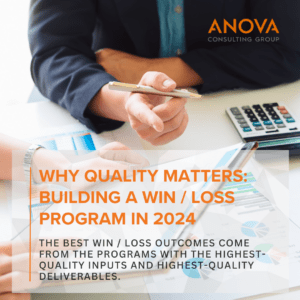 This blog was written by Andrew Cloutier, Partner at Anova.
This blog was written by Andrew Cloutier, Partner at Anova.
If It Sounds Too Good to Be True, It Probably Is. In general, teams are being asked to do more with less, both in terms of budget and FTEs. As such, the automation of processes is an important consideration in terms of cost and time savings.
The rise of automation and generative AI has created exciting opportunities across industries, including win / loss. While the potential of AI is undeniable, it’s important to approach it with a realistic mindset. An advanced AI model, no matter how sophisticated, cannot compensate for flawed data sources or poorly designed processes.
Practitioners of win / loss need to have a point of view and plan for taking advantage of automation and AI-driven opportunities, both for operational efficiency and insight generation purposes. But it is also important not to engage in “magical thinking” as it relates to the fundamental blocking and tackling of gathering and analyzing win / loss data. The most advanced generative AI model in the world is useless if its data source is faulty, and a fully automated survey process isn’t particularly helpful if the survey isn’t getting sent to the right people or generating meaningful responses. In short, if it sounds too good to be true, it probably is.
Qual Matters – High-Quality, Qualitative Feedback from Qualified Respondents
The best win / loss outcomes come from the programs with the highest-quality inputs and highest-quality deliverables.
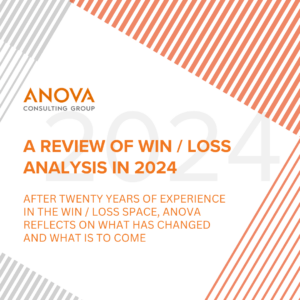 This blog was written by Andrew Cloutier, Partner at Anova.
This blog was written by Andrew Cloutier, Partner at Anova.
As Anova celebrates its twentieth birthday this year, we reflect on the evolution of win / loss analysis—a vital tool for understanding buyer behavior and improving sales strategies. Though much about win / loss analysis has remained consistent over Anova’s tenure, many things have also changed, and the pace of change has accelerated over the last few eventful years. Understanding these changes can make the difference in empowering businesses to stay ahead in competitive markets.
This blog series explores the significant changes we’ve seen over the past decade, the enduring principles, and practical tips on how organizations can run an effective win / loss program in 2024.
What Has Changed in Win / Loss Over the Last Decade
While Anova continues to embrace opportunities to educate sales and marketing executives about the value of win / loss analysis, awareness and adoption of win / loss analysis has dramatically increased across industry verticals. Conversations that used to be about why the voice of the buyer is so valuable have transformed into conversations about how organizations can get the most out of voice of the buyer programs.
Today, organizations have access to a much broader range of win / loss solutions—from homegrown programs to automated surveys and hybrid, custom approaches. It is important for buyers to understand the benefits and drawbacks of various options to ensure they pursue the type of program that will provide the most value to their organization.
A notable shift has been the transition of program ownership from sales leaders to product marketing and/or competitive intelligence teams. Though each of these constituencies are consumers of win / loss insights, maintaining connectivity with sales remains essential for program success. Trust and transparency in the process as well as a free flow of timely win / loss contact information are critical components.
Across industry verticals, Anova has found that the lengthening of sales cycle times and the increasing difficulty for B2B buyers to make buying decisions can be attributed to the following factors:
What Has Stayed the Same in Win / Loss Over the Last Decade
While the macroeconomic climate changes, win / loss remains a critical tool in both bullish and bearish market conditions. When budgets are tight and deal flow is down, each sales opportunity increases in importance, and having an in-depth understanding of buyer perceptions can provide the edge that makes the difference between a loss and a win. Conversely, when budgets are free-flowing and sales are booming, win / loss analysis can provide a key source of best practices and sales training materials for expanding teams. It also serves as a rich source of up-to-date competitive intelligence for both established competitors and new market entrants.
The computing adage “garbage in, garbage out” continues to apply to win / loss analysis. In a win / loss program, a primary source of program inputs is CRM data. Incomplete or inaccurate CRM data is a shaky foundation for an insightful win / loss program. This challenge becomes magnified in solutions that prioritize automation without including proper checks and balances to ensure data quality.
An effective win / loss program is not just a tool for understanding past sales outcomes but a strategic asset that can drive future success. Through the pursuit of continuous improvement, organizations can unlock valuable insights that lead to improved decision-making, competitive advantage, and sustainable growth.